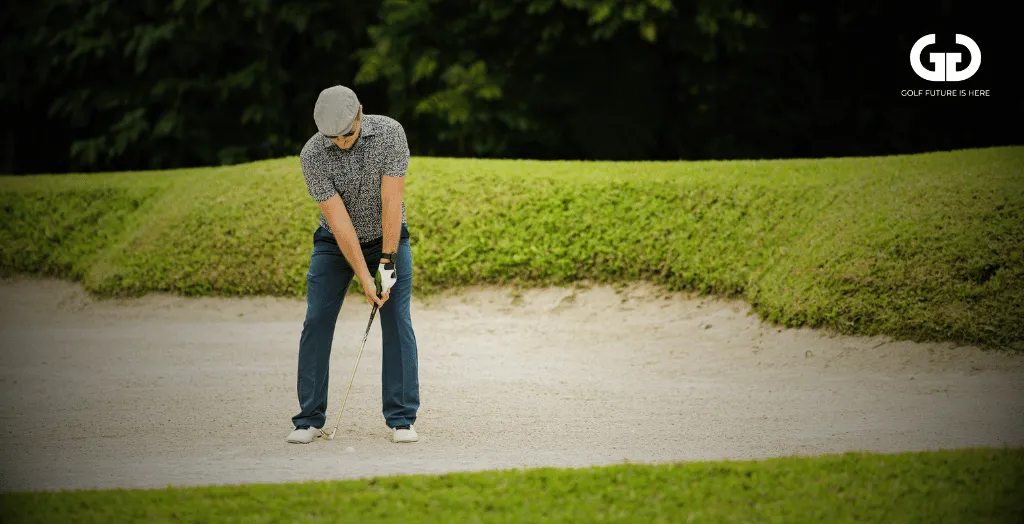The journey from a high handicap to a lower one in golf is incredible and has many challenges.
While one of the crucial ones challenges you to break 100 in golf, it seems pretty tricky if you are starting. However, if you are overconfident, you will think it is a cakewalk.
Breaking 100 requires a lot of practice and following a step-wise approach in the correct direction.
Before starting, remember breaking 100 is different from the 90s and 80s, so keep a positive mindset throughout the guide.
Key Takeaways
- You should start using forgiving clubs and lightweight shafts to improve your game.
- You should focus on your stance and alignment to optimize your shots.
- Make sure that you make solid contact with the ball to reduce misses and improve your overall consistency.
- You must work on optimizing your wrist flexion and extension to get that perfect clubface angle for straighter shots.
18 Tips On How To Break 100 In Golf
Right from equipment, setup, and other fundamentals to wrist flexion and extension, you have to do many things to break 100.
Besides, I didn’t have the opportunity to learn from a coach, but I have implemented them and established myself as an expert player right from a novice. So let’s check in detail!
1. Use The Right Equipment
When playing golf at a handicapped level, the game of golf seems quite tricky. Yet, what if you complicate it more?
You are an amateur golf player, and you would try your best to break 100 in golf. But if you have a superiority complex, you make it more difficult.

There’s dedicated equipment for every golf shot, plus certain norms of what kind you should use as beginners.
But sometimes, in ego, superiority complex, and similar things, you buy expensive equipment or ones that are difficult to master. Hence, the thumb rule of the game is to use the right equipment.
Therefore, use the correct clubs for the suitable shot. Even clubs with heavier and harder shafts aren’t appropriate for novices, so don’t do it.
Forgiving Clubs
When you are a beginner, there are plenty of negative impacts on your shots. Thus, to break 100, managing the negative impacts is essential. This includes effects for off-center hits or bad swings.
Therefore, you should go for golf clubs designed to be more forgiving. They handle mishits and increase the chances of the ball going in the green.
Lightweight Shafts
The durability of steel is unmatchable, and with forgiving clubs, you think you can do wonders. However, it’s not true.
Steel shafts are heavier, which makes it difficult to swing, and with experience, I don’t recommend it to novices.
Therefore, after going for forgiving clubs, choose lightweight shafts which make swinging easier. One of the most incredible lightweights is a graphite shaft that is perfect for beginners.
Using Hybrids And Fairway Woods Instead Of Long Irons
20-handicap or even veteran players often struggle to master golf with long Irons. Therefore, as a novice, do not use long irons when you want to break 100.
Hence, avoid 5-irons and the ones that are longer than that. Even experts say these are the hardest to do.
Instead, go for Hybrids and Fairway Woods to hit more three-par holes successfully. It also helps to hit 4s accurately and 5s from a distance to push the ball near the green.
Use A Dedicated And Effective Club For Tee Shots
When you want to break the 100 in golf, seamless gameplay is essential. If your shots end up in hazards or out of bounds, achieving the goal becomes difficult.
Hence, the core rule here is to manage the misses by keeping the ball in bounds and not in hazards.
So, choose a dedicated and effective club for Tee Shots. It can be anything ranging from hybrids to Fairway woods, depending upon how convenient it is for you.
2. Adjust The Setup
Nailing a game is impossible if you don’t know the correct setup, which includes positioning yourself and the equipment.
Instead, it leads to penalties and misses. You have won half the battle once you become thorough and efficient with setup.
This includes three crucial things:
Grip
The grip is the point of contact between you and the club. It also plays a crucial role in determining how targeted your shots will be.
Thus, choosing the wrong one will be an obstacle to breaking 100. There are three types of grip- weak, strong, and neutral.
Going for the weaker one will lead to more slices and misses. Besides, if your grip is too firm, it won’t be comfortable for your wrist in the long run, leading to snap hooks.
Therefore, a neutral grip helps, distributing your hand pressure and preventing overlapping.
Setup
Setup in golf aims at your body set-up and the ball position. The first step is to keep a proper stance based on your club.
If you have a bigger club, like a Driver, the stance should be wider than your shoulders. In contrast, shorter clubs should be narrower.
Further, your weight should be 60% focused on your dominant leg. This promotes a descending blow and reduces slicing.
Next, there’s no single ball position in golf. It largely depends upon the club you are using. The ball should be off the front heel if you use a driver.
If you use hybrids, longer Irons, or Fairway woods, position the ball at the front center. Besides, with shorter irons or wedges, please keep them in the middle of your stance.
Alignment
Alignment plays a crucial role in an effective backswing and downswing. It ensures you align your body and position correctly at the course. Also, take care of the square.
You might think you are rightly aligned, but I always recommend using alignment aids. You might think you are correct, but little imperfections often exist, ruining your gameplay, especially high handicaps.
3. Have A Strong Contact
Making solid contact means keeping your posture the same throughout the game.
Your posture might vary slightly with time, especially during swings and constant gameplay. These increase slices and misses and even create fatigue.
For some, it does lead to chronic pain issues in the long run. With these things in mind, a posture change would help break 100. Hence, solid contact with the grooves is established, thus minimizing misses.
4. Use A Soft Compression Ball
Soft Compression Balls have lower compression ratings. This means that it will compress easily when the clubface impacts it.
The ball doesn’t go much far compared to high-compression ones, but with a controlled speed, and thus, it prevents you from overshooting your targets.
5. Optimize Wrist Flexion And Extension
Optimizing Wrist Flexion and Extension is one of the most underrated yet complicated measures, but its importance cannot be avoided.
How you move your wrists during your golf swing affects how the clubface looks when it hits the ball and how steep or shallow the club is.
Flexing (bending your wrist forward) will make the clubface point more toward the ground. Thus, the shaft of the club will be steeper.
Further, when you extend (bend your wrist slightly backward), the clubface will print more towards the sky. With this, the shaft of the club will be less steep.
The clubface angle is critical because it determines where the ball will go. An open clubface will make the ball go to the right, while a closed clubface will do the opposite.
Having the right wrist angles will help you hit the ball straighter. Setting up the club with a slight forward lean towards the target creates the correct wrist position.
Keeping this position during your swing and flexing your wrists slightly at impact will give you more power. Thus, it makes the clubface angle square, resulting in straighter shots.
6. Be Aware Of Your Golf Swing
Knowing about your golf swing doesn’t mean being aware of your backswing and downswing but overall. Thus, you can effectively move close to breaking a hundred.
Consistent Practice
Like every other thing, especially golf, consistent practice in the right direction can do wonders.
During this time, you will know more about which swing goes wrong, the mistakes you make leading to misses, and so on.
You don’t have to spend the whole day; instead, dedicate specific hours practicing in the right direction and approach.
Record Your Swing
A wise way to be aware of your swing, apart from consistent practice, is to record it. Yes, it means video recording.
By carefully watching it after your practice session, you must analyze your mistakes, especially in setup, tempo, alignment posture, stance, and backswing/downswing.
7. Don’t Always Use A Driver
The Driver is one of the most enjoyable clubs to play with. However, if you have not gained confidence in using it, then using a Driver is unnecessary.
You can use Fairway Woods, hybrids, or whatever you feel comfortable with. Use them to Lag Putt.
8. Learn To Lag Putt
Remember the time when you used to set shorter targets for study? Even now, you have set smaller targets for your goal, thus increasing the chances of achieving a bigger one.
Similarly, instead of aiming for the green directly in golf, learn to hit the ball near the stroke and not in it directly.
This is more likely to reduce swing and tempo. It leaves you with a short, manageable putt for the next shot and decreases the risk of a three Putt.
9. Make Three Foot Putts Automatic
Making three-foot Putts automatically in golf means you should become well-versed in short-distance swings.
It should be to the extent that when you hit such shots, your hand strikes automatically without a miss or slice. You should pay attention to your tempo, alignment, swing, and posture.
Further, practice consistently till you achieve that confidence and expertise. Thus, you reduce the chance of 3-putts and minimize strokes.
It even makes you confident for longer putts and builds momentum for the longer ones. Besides, since it saves strokes, it reduces the pressure to hit longer Putts. Not to forget, it does improve your score!
Lastly, keep your head steady. Most golfers make the mistake of peeking into the green after every shot, which disturbs their alignment.
10. Don’t Fear The Sand
One of the biggest fears of amateurs and veteran golfers is bunker shots. But there’s nothing to bother about. You should be confident and follow certain practices to nail them as well.

Below-mentioned is a list of the same:
- Distribute 70% of your weight on the front foot. It enables a descending blow onto the sand.
- When you are doing a backswing, you shouldn’t focus on the ball. Instead, emphasize a spot two inches back.
- Use your sand Wedge, as the focus is sand, not the ball.
- Accelerate your shots. You need elevated speed to lift the ball out of the sand.
Next, practice often in the sand to reduce your fear.
11. Strike With Control
Slices are among the most irritating shots for both high and low handicaps. But high handicaps encounter it more.
This is because they often strike excessively and uncontrollably on the curve, leading to a slice. Instead, you should hit in a controlled way with the required swing to break 100.
To help strike with control and avoid slices, analyze your grip and check your alignment, setup, swing path, and clubface angle.
The latter means swinging the inside-to-out path instead of outside-to-in. Next, proper body rotations and hip movements should be made, and grip pressure should be more relaxed.
12. Get Near The Green With Your Approach Shots
One thing you must note is that your goal is to break 100 and not 80’s. Thus, it’s not necessary to hit every ball into the green. You can focus on hitting 75% of shots in the hole.

You can strike your ball with the tee shot near the green. You can aim to put it into the hole in the next one.
Thus, it increases the chances of sinking as the latter involves a shorter distance for the ball to go into the green.
13. Keep The Ball Low Around The Green
Keeping the ball low when it lands on the green is beneficial. This means hitting the ball downward to stay closer to the ground.
Doing so helps you to have better control over the shot and increases the chance of consistent performance.
By keeping the ball low on the green, you can avoid potential hazards and reduce the chances of the ball rolling too far away from the hole, giving you a better opportunity to make accurate and successful putts. Thus, you are moving closer to your goal of breaking 100.
14. Play The Right Tees
The golf course has different tees marked with different colors. Hence, choose the right tee per your expertise level to minimize misses and move closer to your goal.
15. Master Green Reading
Green Reading is one of the simplest yet most effective strategies for breaking 100 in golf. It deals with land topography.
Stand beside your golf ball and see whether you are straight or lean towards one side. In the latter case, it is uneven, and you must adjust your shots according to the curve.
16. Don’t Add Up Your Score
Do not mentally add/tally your score after each shot. This would make you underconfident/overconfident.
Thus, you distract yourself from the present and pressurize yourself with scores.
17. Practice Playing Against Obstacles
Apart from these beginner to advanced-level measures, there are certain obstacles all golfers have to deal with.
This includes harsh weather conditions, annoying playing partners, different layouts and course conditions, and even tucked pins.
You should also keep yourself relaxed and practice playing against all such obstacles. Don’t let them distract you always.
18. Enjoy
When you are not close to your goals, breaking 100 can be annoying. Sometimes, undue pressure or the frustration of keeping pace would also surround you.
But remember not to lose your calm and enjoy the game with a positive mindset.
The Final Word
Breaking 100 in golf is simpler if you divide the process into chunks. The basics are to check your setup, alignment, grip, and equipment and know your swing.
Further, learn to Lag Putt efficiently, play with the right tees, and master green reading.
Next, proceed with the advanced steps, such as wrist flexion and extension, keeping the ball low around the green, and establishing strong contact. Besides, don’t fear the sand, and enjoy the process!
Similarly, to make it easy for you to break 90, and 80, check out our guide on each.
If you have any questions, do let me know in the comments!
Happy-Golfing!
FAQs
Which is the most challenging 100, 90, 80, or 70, to break in golf?
The most difficult break is 70 in golf. Only 1-2% of golfers can break 70 in golf.





0 Comments